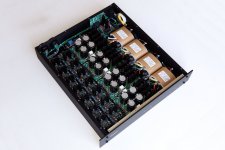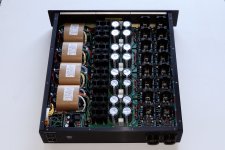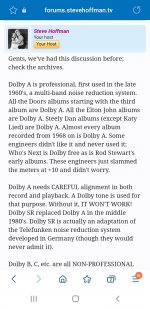Indeed...that CRD means also an even lower psrr for the op-amp and a higher but predictable current draw so some more filtering is needed than on a normal op-amp setup. I saw some guys proving that output loading on one side doesn't work with any op-amp the way they thought...The schematic contains current sources...
Well...his example wasn't a generic simple one as the title suggested and we have to deal with it...Off topic??? The first post says: "For something like a fairly generic OPamp based preamp, is a regulated PSU really that important?"
Cheers
Ian
Here is the power supply chassis for my line amp and phono stage. 19 x 17 inches - 35 lbs
Soft start thermistor and relay, 100 watt R core transformers, DiyAudio power supply boards (meant for a power amp, but work great for preamps too) , Quasimode Bridge snubbing, Separate positive and negative hexfet bridges, CRC filter 240,000Uf/ 50V , then 16 Jung super regulators as +/- 31VDC preregulators - there are local discrete fet shunt regulators for each phase in the preamp and phono chassis.
Soft start thermistor and relay, 100 watt R core transformers, DiyAudio power supply boards (meant for a power amp, but work great for preamps too) , Quasimode Bridge snubbing, Separate positive and negative hexfet bridges, CRC filter 240,000Uf/ 50V , then 16 Jung super regulators as +/- 31VDC preregulators - there are local discrete fet shunt regulators for each phase in the preamp and phono chassis.
Attachments
Last edited:
Q.E.D.Heres the power supply chassis for my line amp and phono stage. 19 x 17 inches - 35 lbs
Soft start thermistor and relay, 100 watt R core transformers, Quasimode Bridge snubbing, Separate positive and negative hexfet bridges, CRC filter 240,000Uf/ 50V , then 16 Jung super regulators as +/- 31VDC preregulators - there are local discrete fet shunt regulators for each phase in the preamp and phono chassis.
We’ve seen this several times already in other threads. 😉Heres the power supply chassis for my line amp and phono stage. 19 x 17 inches - 35 lbs
What is the message or answer to the OP’s question?
He asked about preamp regulated supplies, i showed a regulated version, where’s yours?We’ve seen this several times already in other threads. 😉
What is the message or answer to the OP’s question?
In my preamplifier and power amplifier. 😛i showed a regulated version, where’s yours?
However, OP’s question was not to show pictures of our PS. I count your post as statement that regulated PS is a must. Nothing wrong with bragging (for such fine peace of work), but few words along pictures help better understanding. 😎
Have we met the same guy who had "reference" DIY horn speakers (aka, extremely screechy in the treble), which he mated with super mellow tube amps and non-oversampling dacs? Obviously any solid state amp sounded extremely screechy on these speakers, so he had concluded solid state was evil, the spawn of the demon, too much sibilance, etc. Back in the day I was less of an *******, but damn did I feel the urge to shove some balled up socks into these horn tweeters!I have heard/see some installations of people that don't believe in conventions and standards and that everything active sounds bad, regulators are 666, jitter is no issue (as they have very jittery DACs) etc. They have 8V rms output DACs, 100 mV sensitive tube amplifiers, unshielded silver wire etc. No way that these will accept any standard practice. Trouble for me then is that nothing is interchangeable with normal equipment and comparison seems to prove their point
It is nicely built if a tiny bit overkill, still I notice the absence of HF noise filtering equipment (although it is difficult to see from a distance)Here is the power supply chassis for my line amp and phono stage. 19 x 17 inches - 35 lbs
Soft start thermistor and relay, 100 watt R core transformers, DiyAudio power supply boards (meant for a power amp, but work great for preamps too) , Quasimode Bridge snubbing, Separate positive and negative hexfet bridges, CRC filter 240,000Uf/ 50V , then 16 Jung super regulators as +/- 31VDC preregulators - there are local discrete fet shunt regulators for each phase in the preamp and phono chassis.
Observing the PSRR of opamps which tends to drop steadily with frequency, I've had a hunch that whatever the regulator does at audio frequencies is less important (as long as it's not too bad) than the amount of HF noise going on.
The mathematics of the universe is always a minimalist one...no excess...there's a philosophy we attach to it called "less is more"...
Feedthru caps but no ferrite beads, peufeu?
I'm fond of rectified mains --> LRC filtering --> discrete regulators --> Ferrite & feedthru --> active circuit power rail
LRC filtering reduces HF noise from mains; series resistance of inductor coil doesn't cause problems, we can tolerate it here
discrete reg can be designed to add very little HF noise;
ferrite & feedthru reduces HF noise further, without compromising output impedance
I'm fond of rectified mains --> LRC filtering --> discrete regulators --> Ferrite & feedthru --> active circuit power rail
LRC filtering reduces HF noise from mains; series resistance of inductor coil doesn't cause problems, we can tolerate it here
discrete reg can be designed to add very little HF noise;
ferrite & feedthru reduces HF noise further, without compromising output impedance
Back in the day when we used ASCII terminals to talk about such, I received an email from a fellow reluctant to discuss his findings in the forum, for fear of getting his head bit off from those that know. He described an actual investigation into op-amp psrr, where he designed a circuit to deliberately inject noise onto the PSU rails. His conclusion was "no effect" on music played through until he reached ridiculous amplitude levels that would never occur in any PSU design - while the forum folks were talking milliohms of output Z and uV levels of output noise "making a difference" in their op-amp based phone preamp. I assume he did it with 30+ year old op-amp technology.
Issues within audio design are cyclic. Supposed problems like painted ponies go up and down over years - decades - of time where they're rinsed and discussions repeated. Has anyone in the last few years built the circuitry and tried the objective experiment of my former coworker? No, mostly because that which might be revealed could go against cherished beliefs. One of which is that ultra-fine craftsmanship in PSU circuit design beats the mediocre in all cases of audio signal engineering. Certainly looks like it would be better...got to be...so it must sound correspondingly.
Issues within audio design are cyclic. Supposed problems like painted ponies go up and down over years - decades - of time where they're rinsed and discussions repeated. Has anyone in the last few years built the circuitry and tried the objective experiment of my former coworker? No, mostly because that which might be revealed could go against cherished beliefs. One of which is that ultra-fine craftsmanship in PSU circuit design beats the mediocre in all cases of audio signal engineering. Certainly looks like it would be better...got to be...so it must sound correspondingly.
Thak you!Back in the day when we used ASCII terminals to talk about such, I received an email from a fellow reluctant to discuss his findings in the forum, for fear of getting his head bit off from those that know. He described an actual investigation into op-amp psrr, where he designed a circuit to deliberately inject noise onto the PSU rails. His conclusion was "no effect" on music played through until he reached ridiculous amplitude levels that would never occur in any PSU design - while the forum folks were talking milliohms of output Z and uV levels of output noise "making a difference" in their op-amp based phone preamp. I assume he did it with 30+ year old op-amp technology.
Issues within audio design are cyclic. Supposed problems like painted ponies go up and down over years - decades - of time where they're rinsed and discussions repeated. Has anyone in the last few years built the circuitry and tried the objective experiment of my former coworker? No, mostly because that which might be revealed could go against cherished beliefs. One of which is that ultra-fine craftsmanship in PSU circuit design beats the mediocre in all cases of audio signal engineering. Certainly looks like it would be better...got to be...so it must sound correspondingly.
Ray Dolby might be the most hated man by the audiophile world yet the first to make a in depth analyses of what we hear and what we don't...and probably the most useful man to the recording world until the 90's...
Attachments
Feedthru caps but no ferrite beads, peufeu?
Sure! Caps, ferrites, good damping factor, and most important, ground plane... The LC filters make a really good complement to a regulator.
For example about unregulated power supplies, the designer adds RC filters until he's satisfied with the 100Hz ripple, but unknowingly the good results may just come from the extra HF filtering from all these RCs...
I always use regulated power supply , and I try to have low noise, the OP amp can have 100dB of noise rejection but the layout and the wiring may not ... if you have some noise in the power supply it will flow through decoupling capacitor and into groud rails and so on ... then there will be noise current everywhere
We have star grounds and virtual grounds for such problems...I always use regulation to regulate the supply voltage...if noise can be reduced that way it's a bonus. I need that bonus only if significant currents need to run through that preamp which is pretty rare and there are cures for that too.
Most often than not I only want my op-amps to be safe, but I found that I don't really need them to work at high voltages or high currents...
About safety:
A 220: 12v transformer insures the variations in the supply line are reduced by 18.3 times and the max output voltage around 10...12V pk to pk which is enough for most applications and we're not in bridged mode yet.
A normal phono preamp is not among them unfortunately...
An accidental second phase on the nul as it happens sometimes in my country will lead to 20V ac in the secondary which still guarantee a max 28v supply on the op-amps which is safe for most op-amps.
Using a very low noise virtual ground I don't care about the noises running through the ground return if any...
Most often than not I only want my op-amps to be safe, but I found that I don't really need them to work at high voltages or high currents...
About safety:
A 220: 12v transformer insures the variations in the supply line are reduced by 18.3 times and the max output voltage around 10...12V pk to pk which is enough for most applications and we're not in bridged mode yet.
A normal phono preamp is not among them unfortunately...
An accidental second phase on the nul as it happens sometimes in my country will lead to 20V ac in the secondary which still guarantee a max 28v supply on the op-amps which is safe for most op-amps.
Using a very low noise virtual ground I don't care about the noises running through the ground return if any...
If the goal is to make a good product with certain specifications at reasonable cost .. then stop designing when the requirements are satisfied.Does a regulator eg: 7815/7915 or LM317/LM337 etc actually offer a noticeable performance benefit over just bulk caps or a CRC psu?
On the other hand, for a DIY project, then add lots of regulators and pretty caps with plenty of copper to connect them so that the WOW factor is improved. 🙂
I design some discrete regulator, series and shunt. Some of them I share at my local audio community. According to who built them, it is better than LM317. But they never compared with unregulated version.
Even I also design 5V and 12V regulator for external DAC.
But I only made one of them for my personal use.
Even I also design 5V and 12V regulator for external DAC.
But I only made one of them for my personal use.
In my opinion, the regulator itself is a power amplifier with 100% negative feedback. When we supply current to our audio amplifier through the regulator, the current will be supplied to the load through both the regulator and the audio amplifier. If so, the regulator must have better performance and parameters than the audio amplifier. However, judging only from the price, the regulator obviously does not have the possibility of such high performance. Unless we have very high requirements for voltage stability or extremely low noiseG'day Guys,
Last edited by a moderator:
- Home
- Source & Line
- Analog Line Level
- Is regulation really necessary/desirable for preamps?


